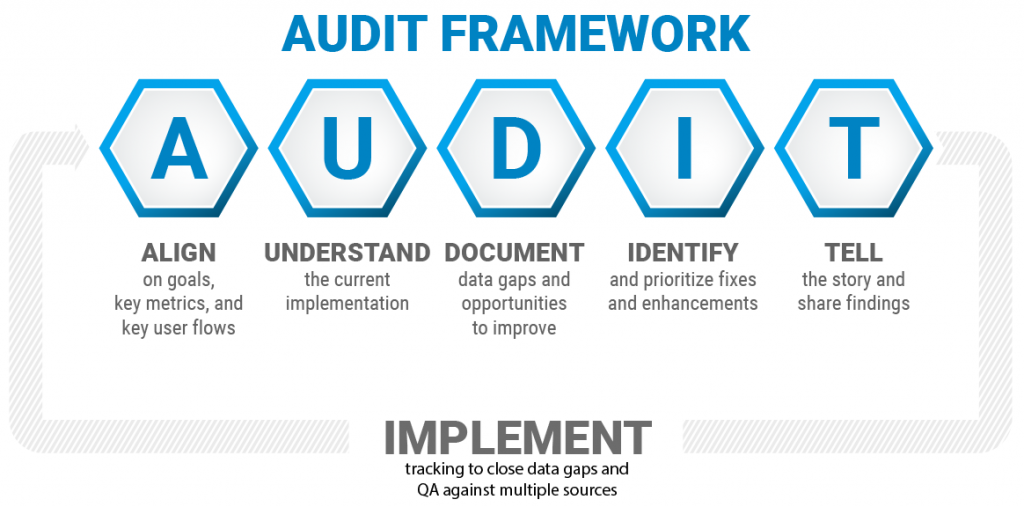An Introduction to the data AUDIT Framework
Do any of the following statements resonate with you, or, maybe, describe how others feel at your company?
- I don’t trust my analytics data.
- Web analytics doesn’t match my backend system of record.
- I know there are issues with my analytics setup.
- I don’t know if there are issues with my analytics setup.
- I know we could be more advanced with our analytics setup.
If any of these statements ring true, you’re not alone. Nearly all of our clients have felt this way at one point in time, and we’ve helped them identify and close gaps in data collection and data quality with a data audit. With certifications and specializations in Google Analytics and Adobe Analytics, an Evolytics data audit investigates key areas of analytics implementation to understand data quality, identify opportunities to fix or enhance data collection, and prioritize recommended actions.

At Evolytics, we follow our proprietary AUDIT framework to ensure we fully understand a client’s measurement needs as well as address gaps in data collection. Our data AUDIT framework includes the following steps:
Align on goals, key metrics, and key user flows
Understand the current implementation
Document data gaps and opportunities to improve
Identify and prioritize fixes and enhancements
Tell the story and share findings
ALIGN
Before you can identify what data is missing or messy, you need to know what data should be collected in the first place. We ask company stakeholders about strategic goals, key metrics, analytics pain points, measurement needs, and past data anomalies to help guide the audit.
In addition to stakeholder feedback, we review current analytics documentation such as variable maps, report examples, and measurement plans. Combining this information with stakeholder feedback, we assess potential misalignment between what stakeholders say they need and what the current analytics implementation actually delivers.
UNDERSTAND
Once we know what should be measured, we compare that baseline to the current implementation to understand potential gaps in data collection. Applying a magic secret sauce of automated routines and expert hands-on assessment, we evaluate the current analytics setup against a matrix of best practice criteria, based on industry standards and our lengthy experience with web analytics technologies. We dig into every corner of the implementation, exploring areas such as anomaly detection, administrative settings, and key flow tracking calls.
DOCUMENT
Working through our evaluation matrix, we document whenever the current implementation falls short of measurement needs or best practices. We also record all enhancement opportunities that would enrich current data or capture new data for increased insight into site traffic, behavior, and conversion. To reveal potential breakdowns in key flow tracking, we document every step in each flow both visually and technically, providing screenshots of each step’s page or action and associated tracking calls, events, and key variables.
IDENTIFY
After thoroughly documenting the current setup, we identify and describe all gaps between stated measurement needs and actual data collection. We don’t simply say what’s wrong. Rather, we recommend a course of action for each item discovered in the audit. We also assess the criticality and level of effort of each item to prioritize which ones need immediate attention and which ones can be added to an analytics evolution roadmap.
TELL
The final step of the AUDIT process is telling the story of the current state of analytics tracking and sharing prioritized opportunities for fixes and enhancements. We compile and present overall findings from the audit in a summary report, highlighting the most critical items discovered during the audit. Finally, our prioritized action item checklist enables a seamless transition from defining action to actually taking action and improving the analytics implementation.
—
If you’re longing to fully trust your analytics data again or need your stakeholders to trust the data as much as you do, then you’re ready for an audit. Hopefully our AUDIT framework gives you some ideas on where to start, but if you need help assessing your analytics data quality, let’s chat about it.
